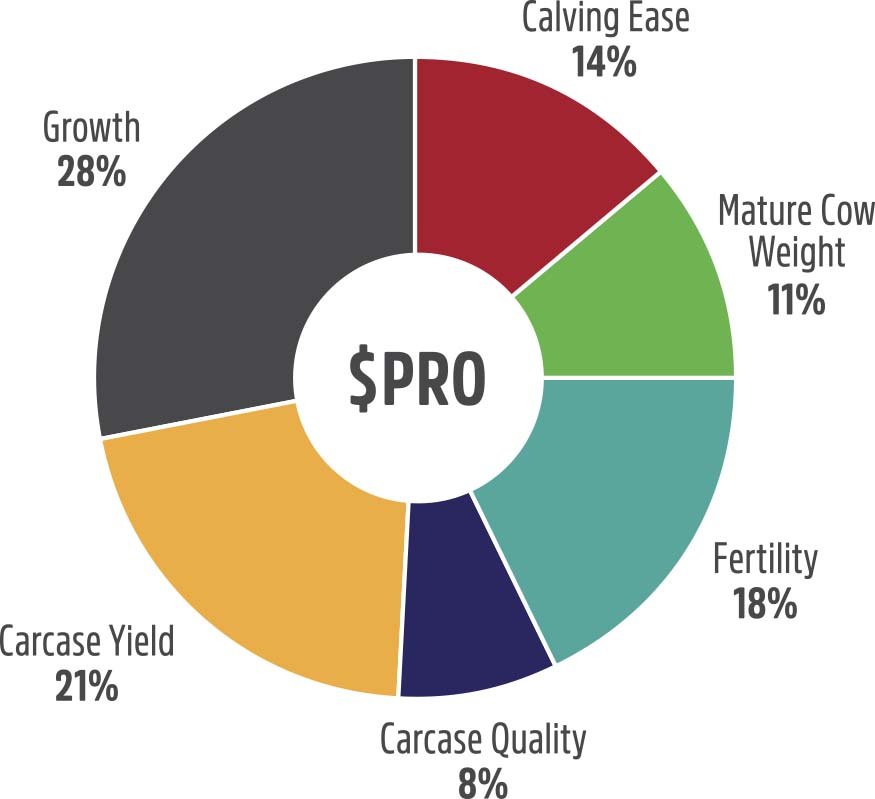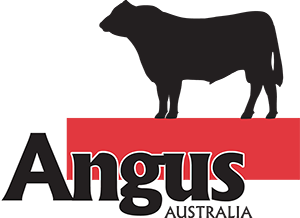
Indexes
$PRO • $A
AngusPRO Index ($PRO)
“The AngusPRO index ($PRO) has been developed by Angus Australia specifically for New Zealand farming conditions and beef markets.”
— AngusPRO
The AngusPRO index ($PRO) estimates the genetic differences between animals in net profitability per cow joined in a commercial self replacing herd based in New Zealand that targets the production of grass finished steers for the AngusPure programme.
Daughters are retained for breeding and therefore female traits are of importance.
Steers are assumed marketed at approximately 530 kg live weight (290 kg carcase weight with 10 mm P8 fat depth) at 20 months of age, with a significant premium for steers that exhibit superior marbling.
Trait Contributions
Figure 1 (below) shows the traits that are considered in the $PRO index, and how much they contribute to the overall balance of the selection index. The larger the segment, the greater the impact on the selection index.
Selection Advantage
Figure 2 shows the selection advantage if animals are selected using the $PRO index.
The selection advantage is calculated by ranking well used sires within the Angus breed on the $PRO index, and comparing the average EBVs of the sires in the highest 10% with the average EBVs of all sires from which they were selected. For example, the sires ranked in the highest 10% based on the $PRO index had 9 kg higher 400 Day Weight EBVs and 1.2 kg lower Birth Weight EBVs than the average EBVs of the sires from which they were selected.
The selection advantage is indicative of the long term direction and relativity of response that will occur in individual traits if selection is based on the $PRO index. The actual response that is observed will vary depending on the features of the individual breeding program.
A feature of the $PRO index is a selection advantage of close to 0 for mature cow weight, meaning that selection on this index will maintain mature cow weight, while still increasing growth to 200, 400 & 600 days of age.
Angus Breeding Index ($A)
The Angus Breeding Index ($A) estimates the genetic differences between animals in net profitability per cow joined in a typical commercial self replacing herd using Angus bulls.
This selection index is not specific to a particular market end-point, but identifies animals that will improve overall net profitability in the majority of commercial, self replacing, grass and grain finishing beef production systems.
Daughters are retained for breeding and therefore female traits are of importance.
The $A index caters for production systems where pasture is fully utilised for the majority of the year. The $A index also aims to maintain mature cow weight.
Trait Contributions
Figure 1 (below) shows the traits that are considered in the $A index, and how much they contribute to the overall balance of each selection index. The larger the segment, the greater the impact on the selection index.
In the $A index there is a focus on improving growth, carcase, calving ease and fertility traits, while maintaining mature cow weight.
Selection Advantage
Figures 2 shows the selection advantage if animals are selected using the $A index.
The selection advantage is calculated by ranking well used sires within the Angus breed on each respective selection index, and comparing the average EBVs of the sires in the highest 10% with the average EBVs of all sires from which they were selected. For example, the sires ranked in the highest 10% based on the $A index had 13 kg higher 400 Day Weight EBVs and 0.9 kg lower Birth Weight EBVs than the average EBVs of the sires from which they were selected.
The selection advantage is indicative of the long term direction and relativity of response that will occur in individual traits if selection is based on the $A index. The actual response that is observed will vary depending on the features of the individual breeding program.
The selection advantage of the $A index for mature cow weight is close to 0, meaning that selection on this index will maintain mature cow weight, while still increasing growth to 200, 400 & 600 days of age.







